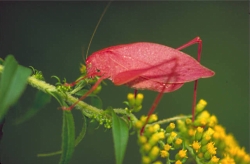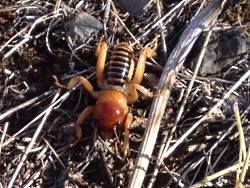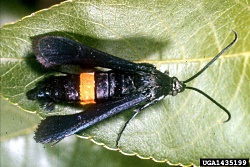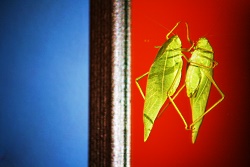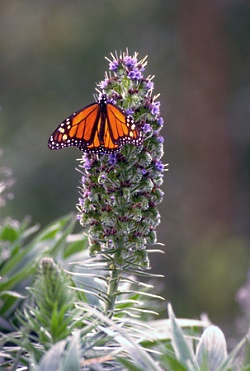
Anabrus-simplex
Courtesy & Copyright Shannon Rhodes, Photographer
Decades later, near Fremont Indian State Park, I met a Mormon cricket for the first time. I cringed as I watched thousands of these creatures hopping across the mountain path that afternoon, and I understood how merciful those California gulls must have seemed, swooping in to gobble up the insects, as the Mormon pioneers struggled to develop a defensive, crop-saving plan as newcomers to this land.

Anabrus-simplex
Courtesy & Copyright Shannon Rhodes, Photographer
Did you know that Mormon crickets are not crickets, grasshoppers, or cicadas, but large shield-backed katydids that walk or hop rather than fly? Their smooth, shiny exoskeleton can be a variety of colors and patterns, like the reddish-brown female I chased and studied this summer in Fishlake National Forest. They have long antennae, and each female has what looks like a long curving stinger extending from her abdomen. This ovipositor allows her to deposit 100 eggs or more that look like gray or purple rice grains just below the soil surface. The males, on the other hand, lack this structure, but they “sing” as a way to attract females, and reward their mates with protein-packed spermatophore prizes.
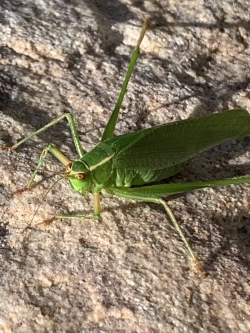
Courtesy & Copyright Shannon Rhodes, Photographer
For Wild About Utah, I’m Shannon Rhodes.
Credits:
Images: Courtesy & Copyright Shannon Rhodes, Photographer
Audio: Courtesy & © Kevin Colver https://wildstore.wildsanctuary.com/
Text: Shannon Rhodes, Edith Bowen Laboratory School, Utah State University https://edithbowen.usu.edu/
Additional Reading Links: Shannon Rhodes
Additional Reading:
Anderson, Rebecca. Miracle of the Crickets. Utah Humanities. 2011.
https://www.utahhumanities.org/stories/items/show/223
Capinera, John and Charles MacVean. Ecology and Management of Mormon Cricket. Department of Entomology Colorado State University. 1987.
https://www.nativefishlab.net/library/textpdf/17378.pdf
Church of Jesus Christ of Latter-day Saints. Crickets and Seagulls. https://www.churchofjesuschrist.org/study/history/topics/crickets-and-seagulls?lang=eng
Cowan, Frank. Life History, Habits, and Control of the Mormon Cricket. United States Department of Agriculture. 1929. https://naldc.nal.usda.gov/download/CAT86200155/PDF
Hartley, William. Mormons, Crickets, and Gulls: A New Look at an Old Story. 1970. https://issuu.com/utah10/docs/uhq_volume38_1970_number3/s/107089
Kent State University. Study Reveals Mass Migration Of Mormon Crickets Driven By Hunger, Fear. ScienceDaily. ScienceDaily.com, 2 March 2006. https://www.sciencedaily.com/releases/2006/03/060302174524.htm
National Geographic. Giant Swarm of Mormon Crickets. https://www.youtube.com/watch?v=Yy3dQJYquoY
Palmer, Matt. Get a Jump on Mormon Cricket and Grasshopper Management. https://extension.usu.edu/pests/slideshows/ppt/03sh-insects-mc.pdf
Selden, George, and Garth Williams. The Cricket in Times Square. New York: Ariel Books, 1960. https://www.amazon.com/Cricket-Times-Square-Chester-Friends/dp/0312380038
University of Wyoming. Mormon Cricket Biology and Management poster. https://owyheecounty.net/wp-content/uploads/2018/06/MormonCricketbiologymgmtposteruofWYB1191.pdf
The Wild Episode. Mormon Cricket: The Cannibal Swarm.
https://thewildepisode.com/2020/12/11/mormon-cricket-the-cannibal-swarm/
Wild About Utah Posts by Shannon Rhodes https://wildaboututah.org/author/shannon-rhodes/

